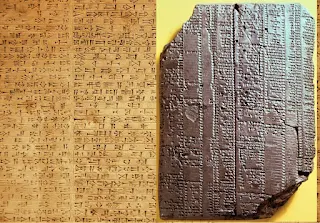p The Cosmic Connection
In a twist that bridges the ancient with the cutting-edge, a groundbreaking study published in the Proceedings of the National Academy of Sciences has unveiled an unexpected link between 3,000-year-old Babylonian cuneiform tablets and the perplexing anomalies that occasionally disrupt Earth’s geomagnetic field. Delving into the rich Mesopotamian cultures, researchers have unearthed a connection that could revolutionize our understanding of the enigmatic forces governing space.
When Ancient Script Meets Modern Science
Amidst the wonders of ancient civilizations, who would have thought that the secrets of space could be locked within the inscriptions of Babylonian clay? The intersection of archaeology and astrophysics has opened a portal to unravel the mysteries of Earth’s geomagnetic field, providing a unique perspective on anomalies that have baffled scientists for centuries.
The Bermuda Triangle of Space
As if torn from the pages of science fiction, the Earth’s geomagnetic field occasionally plays tricks, creating anomalies that disrupt spacecraft, confound satellites, and even leave astronauts reporting blindingflashes of light. Known as the Bermuda Triangle of space, NASA has been diligently tracking one such anomaly, the South Atlantic Anomaly (SAA). The Babylonian tablets unexpectedly come into play in understanding these cosmic riddles.
The Mesopotamian Time Capsule
Led by the University College London, a team of researchers embarked on a journey through time by studying Babylonian cuneiform tablets using a method known as archaeomagnetism. These ancient clay records provided a high-resolution snapshot of an anomaly similar to the SAA, named the Levantine Iron Age Anomaly (LIAA). The tablets, inscribed with the names of specific kings, became an archaeological treasure trove, offering a glimpse into changes in the Earth’s magnetic field strength over several decades.
Bridging Ancient Wisdom with Modern Understanding
Co-author Lisa Tauxe emphasizes the significance of this cosmic revelation: “The well-dated archaeological remains of the rich Mesopotamian cultures…provide an unprecedented opportunity to study changes in the field strength in high time resolution.” The marriage of ancient artifacts with modern scientific methods has the potential to unlock key insights into Earth’s magnetic mysteries.
Anomalies in Earth’s Deepest Core
The study not only sheds light on the Levantine Iron Age Anomaly but hints at the existence of similar phenomena beneath the Earth’s surface. Geoscientists now have clues about how the planet’s deepest core influences these magnetic anomalies, offering a tantalizing glimpse into the forces that affect our planet’s most far-flung explorers.
Connecting the Dots Across Continents
Building on previous research, scientists traced the LIAA across ancient fragments from Levant eastern Anatolia to Georgia, examining pottery shards and baked-clay fragments. The findings suggest a global connection, as Moroccan stalagmites were also instrumental in mapping the LIAA. The implications are profound, hinting at a more interconnected and dynamic Earththan previously imagined.
A Cosmic Symphony Unearthed
The convergence of ancient Babylonian wisdom with modern scientific prowess has unlocked a cosmic symphony hidden within the Earth’s magnetic anomalies. As researchers delve deeper into the Levantine Iron Age Anomaly, the realization dawns that the secrets of space may have been inscribed in clay tablets millennia ago, waiting for the inquisitive minds of the 21st century to unravel.
Embarking on a Cosmic Journey
In a world where budget priorities often favor STEM fields, this discovery underscores the irreplaceable value of the humanities. The melding of archaeology and astrophysics opens new avenues of understanding, reminding us that the mysteries of the universe may be hidden in the unlikeliest places. As we embark on a cosmic journey guided by ancient inscriptions, the Babylonian tablets stand testament to the timeless curiosity that drives humanity’s quest for knowledge. Thank you for joining us on this extraordinary expedition into the cosmic unknown.



No comments:
Post a Comment